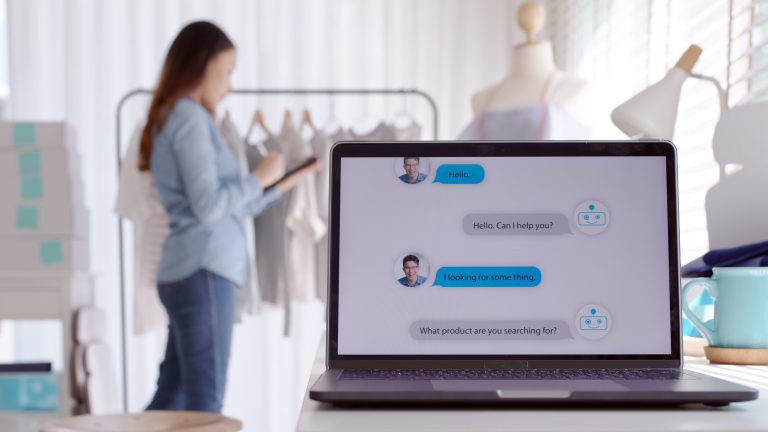Published on: June 20, 2023 Updated on: January 21, 2024
7 Super Conversational AI Use Cases for All Needs
Author: Alex Tyndall

If you’ve ever spoken to a virtual assistant like Amazon’s Alexa or Apple’s Siri, or asked questions to pop-up chatbots on banking websites and SaaS pages, then you’ve used conversational AI (artificial intelligence).
It’s an incredibly useful tool and one of the most common forms of AI we’re exposed to in day-to-day life. It’s no wonder there are applications for it in almost every industry around the world.
Today we’ll be taking a look at some use cases of conversational AI, as well as how it works and where it can be most effectively implemented. If you’re not yet using it in your business, read on and find inspiration from how others have already taken advantage of it.
What is conversational AI?
The main goal of conversational AI is to imitate and replicate human spoken and written interaction.
It does this through extensive training using large-language models and machine learning algorithms to break down the components and nuances of the human language. There are three distinct parts to developing an effective AI chatbot with strong conversational skills.
- Natural language processing (NLP): Everything starts with a user messaging the chatbot. NLP allows the AI to process what is asked and break down key words or phrases.
- Natural language understanding (NLU): After processing the input, meaning can be derived and understood. This involves machine reading comprehension, semantic parsing (converting language to a logical form for machines to understand), and sentiment analysis.
- Natural language generation (NLG): Once everything has been condensed and understood, an AI can generate a response. NLG involves the creation of the final answer and looks at how AI technology pieces human language back together in a coherent, understandable format.
Conversational AI use-cases
Let’s take a look at some examples where conversational AI chatbots and natural language processing can be used with great results. It’s a very versatile technology, allowing you to automate many important processes which would otherwise be time-consuming or repetitive.
1. Healthcare
The impact that AI can have on the healthcare industry is huge. Already we have seen algorithms being used to detect cancerous cells, assist with surgery, and handle large amounts of patient data.
Now, conversational AI chatbots are being used to help talk to patients and understand their problems.
- Appointment scheduling: In many circumstances, it can be very difficult to talk to a nurse or doctor to schedule an appointment because of how busy they are. AI systems can help with that. This reduces administrative stress on hospitals and GPs and helps to reduce waiting times.
- Diagnosis: When you go on the internet and research your symptoms, you won’t find what you need, or you’ll be presented with a list of worst-case scenarios. An AI chatbot trained exclusively on medical data can help diagnose potential issues more accurately and offer referrals to relevant medical professionals.
- Follow-ups: An important part of good healthcare practice is to follow up with a patient to make sure they are recovering well. When doctors are too busy to do so, AI can step in and help. It can ask about recovery progress, provide instructions for home care, and alert healthcare providers if there are concerning symptoms or issues.
- Professional support: AI chatbots can do more than just help patients. They can assist medical professionals in making informed decisions by providing access to relevant medical literature, guidelines, and patient data. It can also help analyze complex medical information, suggest potential diagnoses or treatment options, and support evidence-based decision-making.
2. Customer support
A vital part of developing an awesome business is to make your customers’ experiences top-notch. Unfortunately, this can mean that you need to be available 24/7 to answer a host of customer queries, no matter how ridiculous they may be.
E-commerce can come with a lot of confusion. Whilst it’s nice to buy from anywhere around the world, you’re often only left with the information given on the screen, unable to talk to someone as you would if you were to purchase in person. In the fashion industry, for example, finding a standardized sizing can be very difficult since ‘size 6’ can look different depending on which brand it comes from.
Chatbots or website-specific virtual assistants can improve the user experience by:
- Being present to answer frequently asked questions (FAQs)
- Helping users navigate a site
- Finding similar products
- Explaining features of a product or service
This one-on-one attention is bound to heighten customer satisfaction and help towards more lead generation for your business as it can both target and persuade potential customers.
It also vastly reduces operating costs as it means that a lot more work can be done by only one or two human agents. You don’t need a huge marketing or customer service team in order to run a good business.
Incorporating AI into your CRM (customer relations management) allows for greater self-service, customer engagement, and scalability, as you won’t be bound by the restrictions of a human team. Additionally, if there’s anything you want to upsell, you can always instruct your AI chatbot to slip in a promotion in the conversation!
3. Personal assistants
Let’s be honest. Keeping yourself in check can be hard work, especially if you’re a busy person. Fortunately, there are a bunch of mobile apps that offer virtual assistants which can help you stay organized and ready for everything life throws at you.
- Voice assistants: Many electronic devices in a home can now be controlled by automatic speech recognition (ASR), including your TV, lights, or thermostat. These points are connected to a home control base, such as Google Home or Amazon Alexa. Not only is this super convenient, but it also grants more freedom to people with limited mobility or chronic pain.
- Calendar integrations: It’s so frustrating to arrange a date somewhere but then forget to put it into your calendar. Fortunately, AI can integrate with your texts and calendar to synchronize the two and make sure you never miss an appointment again.
- Personalized entertainment: When you use a virtual assistant, it learns more about you over time. So, when you want to find something entertaining, your AI can show you recommendations based on the news you interact with or which social media apps you favor.
4. Financial services
Conversational AI applications can also be used to help when it comes to managing finances and making financial decisions. There’s often a lot of confusion around money which can cause severe anxiety. But, by utilizing chatbots and other virtual assistants, you can be sure you’re making the right choices.
So, whether you’re a financial institution or a wannabe investor, let’s look at how conversational AI tools can come in handy.
- Personalized advice: When AI is able to analyze your data, such as transaction history, spending patterns, and financial goals, it can offer insightful, personalized financial guidance. This can help you with budgeting, saving, and investment strategies. It can also make suggestions and predictions based on individual needs and risk profiles.
- Fraud detection and prevention: NLP and speech recognition can help detect potential fraudulent activities by analyzing customer interactions and transaction data in real-time. If your bank receives a call claiming to be you, they can analyze the voice and speech patterns and, based on previous data, detect whether the call is real or fraudulent.
- Planning and support: Conversational AI can help customers when applying for loans or planning major financial decisions. Not only can they guide you through the process, but they’re also able to verify your eligibility and direct you to other plans which may work better for you. The AI system can perform initial credit assessments, evaluate risk factors, and provide instant decisions or recommendations, expediting the loan approval process. This means you don’t have to wait for a human to help you, and you can go about your business outside of regular bank-opening hours.
5. Transport
The transport industry is vast and complex, with many moving pieces that must operate non-stop. So it’s safe to say that it can sometimes be quite tricky to navigate. Fortunately, as with financial assistance, conversational AI platforms can step in and clear a path to give you direct answers and get you from A to B.
- Travel routes and recommendations: AI can offer personalized travel planning by considering factors such as customer preferences, budget, and time constraints. If there’s a disturbance to your travels or you wish to go a certain way, AI can suggest optimal routes and transportation options to get you there as quickly as possible. When you’re looking at how to travel somewhere, your AI chatbot can also suggest ideal modes of transport, taking into account things such as fuel efficiency, road closures, or congestion.
- Customer support: As with retail services, transportation services need to have a contact center where customers can go for more information. Chatbots and virtual assistants can help with inquiries, provide real-time information on routes, schedules, fares, and help with ticket booking and reservations. This can streamline customer support, reduce wait times, and provide accurate and timely information.
- More public transport: Isn’t it annoying when there’s no public transport near your house? Well, AI chatbots can help with that, too. The Hong Kong Mass Transit Railway (MTR) utilized AI to direct customers to metro stops and flag up areas where more public transport was needed. Whilst you can’t exactly redirect a train, it’s an example of how AI can be used to look at areas where people need public transport the most and provide insights into how to make areas more accessible in the future.
6. Education
EdTech is one of the largest growing AI industries in the world, so it’s no wonder that conversational AI solutions can be found here as well. Let’s take a look:
- Clarification and understanding: Homework can be a nightmare, especially when you don’t understand it. Fortunately, when schools make use of AI chatbots, they’re able to help eliminate any pain points by providing clarification on tasks set by your teachers.
- Virtual tutors and personalized learning: Over the pandemic, everyone had to get used to Zoom meetings and distanced learning. It turned out that this was preferential for many people, which led to greater accessibility of virtual tutors. Conversational AI can act as a teacher outside of the classroom, offering personalized learning experiences to students. Depending on how you work best, the AI can guide you through tasks to make sure you understand them to the best of your ability. They can also offer additional resources or practice exercises based on individual needs and learning styles.
- Language learning: The great thing about AI is its scope for potential. AI chatbots can communicate in any language they’re programmed to, meaning anyone around the world can use them. Moreover, it can facilitate language learning by engaging students in interactive conversations, providing pronunciation feedback, and offering language exercises and quizzes. AI-powered language tutors can simulate real-life conversations and offer personalized language practice opportunities to enhance language acquisition.
There’s so much more that AI is capable of when it comes to education. If you’re a teacher who would prefer to have a little assistance, then you can use conversational AI as a virtual teaching sub who is there to help you rather than replace you. These AI-powered assistants can handle routine administrative tasks, such as taking attendance, managing schedules, providing reminders, and organizing digital resources.
It also makes it much easier to cater to students with learning disabilities who may require more help or alternate learning strategies. This includes:
- Speech-to-text and text-to-speech functions
- Audio captioning
- Additional resources in different formats
But it’s important to note that AI should be used to enhance the learning experience, not to replace human interaction in the classrooms. For older students, it can be a great tool to teach yourself more about the world or your specialist field, but younger students still need human conversations, which are vital for personal development.
7. Mental health
Aside from more business focused interactions like the customer experience and customer satisfaction, conversational AI can be used for more sensitive cases, like for mental health.
Many people, especially elderly people, experience loneliness. However, a conversational AI platform can help this by always offering a chat. While we may think AI-powered chatbots will feel too robotic to have sensitive conversations with, the technology is so advanced that it’ll feel as if we are talking to a person.
Some apps have already jumped at the chance of automating therapy and using AI for better causes. One that stands out is called Youper. They claim that their chatbot is clinically validated and has been proven to lower levels of anxiety and depression.
By combining psychology with natural language understanding, the chatbot can have empathetic conversations while pointing users in the direction of treatments or solutions to their symptoms.
The benefits of using a conversational AI platform for therapy include:
- 24/7 support
- Anonymity that can help people open up
- More accessible than conventional therapy
Conversational AI chatbots to try
So, we’ve explored the use cases of this artificial intelligence, but now why not try it out yourself? Well, the likelihood is that you’ve already interacted with virtual assistants but didn’t even realize it! There are plenty of great conversational AI solutions to try out, so start with our top picks.
ChatGPT
It’s an obvious first choice, but that’s because it’s truly impressive! If you haven’t tried out this impressive chatbot yet, head over to OpenAI and start chatting. You can use ChatGPT’s older model, 3.5, for free and it will give you a good idea of what can be achieved.
Its simple interface means you can prompt the bot with any request you can imagine and they will respond as best as possible. The following are just a couple of examples of what this powerful technology can achieve:
- Generate song lyrics
- Write a story
- Write code
- Brainstorm ideas
If you enjoy the experience and find it useful, you can sign up for GPT Plus and use the latest, more advanced model.
Microsoft Bing
This conversational AI system is a great option for reliable, fact-checked information. Unlike ChatGPT, it can search the internet in real time to influence its answers. It will then link to the sources it has used in its response so you can double check any information for accuracy.
This app also has image generation built in. Meaning you aren’t restricted just to text generation. This can be great fun to play around with, but also has some helpful use cases, like:
- Generating images for blog posts
- Creating on-brand images for businesses
- Helping creativity
Character AI
Character AI is the conversational AI platform to play around with and really see the creative potential of this technology.
Imagine being able to chat with famous celebrities or even characters that you’ve imagined. Well, that’s all possible. This app offers plenty of famous figures as chatbots that have been trained on lots of data to reply and chat just as that celebrity would.
If you want to let your creative juices flow, create characters from scratch and see where your conversation takes you!
Final thoughts
At the end of the day, it can be a little unsettling for a customer, patient, or student to only speak to an AI. They may feel cast aside or not taken seriously. Finding that balance between AI usage and human interaction is the key to success.
So, whether you’re a big business looking to improve output and workflow, a doctor wanting to take care of more patients (with a little bit of help), or just someone who wants to change channels on the TV but can’t find a remote, conversational AI is there to help you wherever you need it.
To find out more about the many uses of AI, stay in touch with Top Apps!
Alex Tyndall
With a passion for exploring the latest apps and software, she brings a wealth of knowledge to her role as a professional writer at TopApps.ai.
Recent Articles

In 2024, your smartphone camera is about to get a whole lot smarter. AI camera apps are transforming the way we capture and...
Read More
Learn how to use advanced search tools, newsletters, and reviews to uncover the perfect AI-focused podcast for you.
Read More
AI chatbot vs virtual assistant? who reigns supreme? We're dissecting the differences, strengths, and weaknesses, using data-driven insights.
Read More